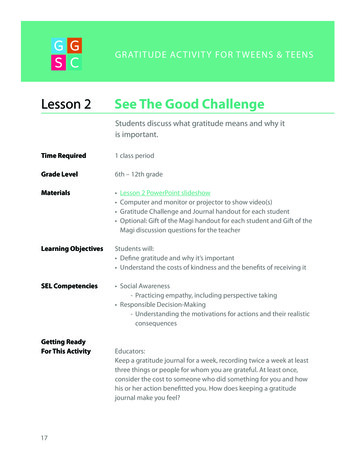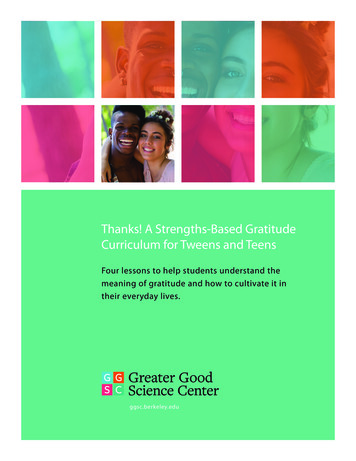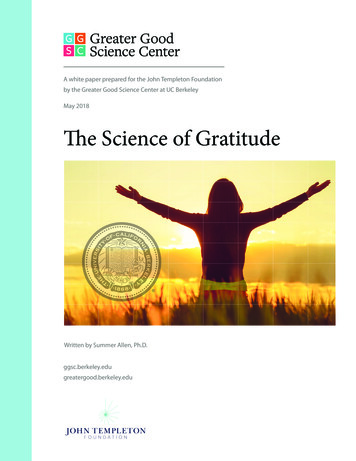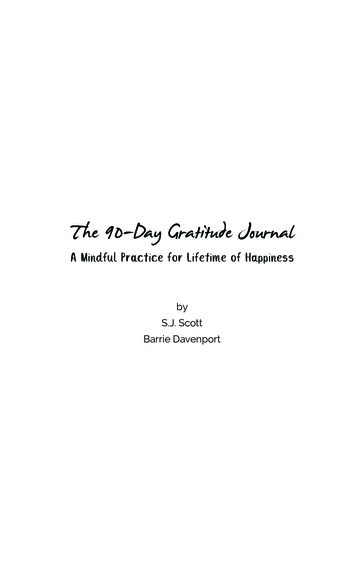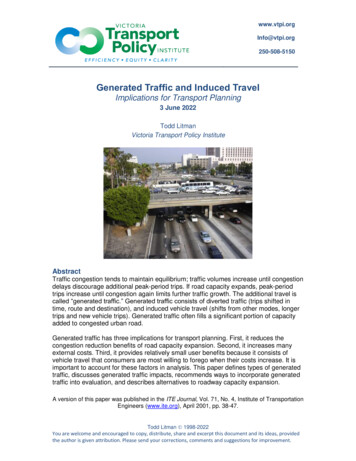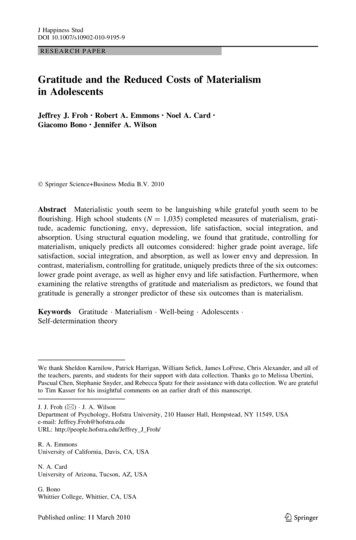
Transcription
J Happiness StudDOI 10.1007/s10902-010-9195-9RESEARCH PAPERGratitude and the Reduced Costs of Materialismin AdolescentsJeffrey J. Froh Robert A. Emmons Noel A. CardGiacomo Bono Jennifer A. Wilson Ó Springer Science Business Media B.V. 2010Abstract Materialistic youth seem to be languishing while grateful youth seem to beflourishing. High school students (N 1,035) completed measures of materialism, gratitude, academic functioning, envy, depression, life satisfaction, social integration, andabsorption. Using structural equation modeling, we found that gratitude, controlling formaterialism, uniquely predicts all outcomes considered: higher grade point average, lifesatisfaction, social integration, and absorption, as well as lower envy and depression. Incontrast, materialism, controlling for gratitude, uniquely predicts three of the six outcomes:lower grade point average, as well as higher envy and life satisfaction. Furthermore, whenexamining the relative strengths of gratitude and materialism as predictors, we found thatgratitude is generally a stronger predictor of these six outcomes than is materialism.Keywords Gratitude Materialism Well-being Adolescents Self-determination theoryWe thank Sheldon Karnilow, Patrick Harrigan, William Sefick, James LoFrese, Chris Alexander, and all ofthe teachers, parents, and students for their support with data collection. Thanks go to Melissa Ubertini,Pascual Chen, Stephanie Snyder, and Rebecca Spatz for their assistance with data collection. We are gratefulto Tim Kasser for his insightful comments on an earlier draft of this manuscript.J. J. Froh (&) J. A. WilsonDepartment of Psychology, Hofstra University, 210 Hauser Hall, Hempstead, NY 11549, USAe-mail: Jeffrey.Froh@hofstra.eduURL: http://people.hofstra.edu/Jeffrey J Froh/R. A. EmmonsUniversity of California, Davis, CA, USAN. A. CardUniversity of Arizona, Tucson, AZ, USAG. BonoWhittier College, Whittier, CA, USA123
J. J. Froh et al.1 IntroductionAs children grow into adults, they internalize attitudes and values from society. Societalconcerns impact the direction in which the self develops and the importance placed onvarious life domains. This socialization process has been well studied for numerous aspectsof culture, including how children begin to think of their gender, their race, their sense ofself, as well as other aspects of their identities (Kasser 2005)—including their materialisticvalue orientation (Kasser et al. 2004). Indeed, in addition to experiences that inducefeelings of insecurity (e.g., divorce; Rindfleisch et al. 1997), exposure to materialisticsocial models exerts a direct influence on children acquiring and internalizing materialisticvalues (Kasser et al. 2004).When materialistic values become essential to a person’s value system, personal wellbeing decreases because it is likely that experiences supporting basic psychological needswill decrease and thus these needs will go unmet (Kasser et al. 2004; Kasser and Ryan1993, 1996). Gratitude, however, seems to have an opposite effect on personal well-beingpartly because it helps people fulfill the basic psychological needs of competence,autonomy, and relatedness (Kneezel and Emmons 2006). And because materialism is aproblem for youth, and concerns about rising material strivings are increasing amongparents, educators, and scientists (Chaplin and John 2007), the purpose of this study was toexamine the effects of materialism and gratitude on social, emotional, and academicfunctioning in adolescence.1.1 Theoretical FrameworkSelf-determination theory (SDT; Ryan and Deci 2000) suggests people have three innateneeds that drive self-motivation, personality integration, and successful self-regulation:competence, autonomy, and relatedness. Competence is a desire to affect one’s environment and achieve valued outcomes within it (Deci and Ryan 2000). Autonomy is the desireto engage in self-selected behaviors that are concordant with one’s strengths and personality (Deci and Ryan 2000). And relatedness is the desire to feel connected to others andhave a sense of belonging (Deci and Ryan 2000).These needs appear crucial for well-being (Ryan and Deci 2000). Valuing intrinsicaspirations (e.g., affiliation, growth, and community) is related positively with well-beingand negatively with depression and anxiety; however, valuing extrinsic aspirations (e.g.,wealth, fame, and image) is related negatively with well-being and positively withdepression and anxiety (Kasser and Ryan 1993). People who over invest in extrinsic ormaterialistic goals are more likely to experience mental illness, not mental health, becausethe fulfillment of basic psychological needs may remain unmet (Kasser 2002). Forexample, needs of autonomy and competence would not be fulfilled if an individual wereto buy a particular brand of apparel to impress peers, and this choice then has the effect ofcompromising their ability to successfully execute an important task (e.g., job, duty) orvalued activity (e.g., sport, hobby). If, however, an individual buys a brand of apparel thatimproves their ability to engage in a task or activity and improves their execution of thattask or activity, then they are likely to fulfill their needs for autonomy and competence.Indeed, materialistic adolescents may be less likely to report being intensely absorbed orengrossed in a personally meaningful activity (Kasser 2002), unlike grateful adolescents(Froh et al. 2010). This may happen because materialistic values: (a) focus people more onthe external rewards of an activity than on interest and challenge; (b) lead people tobecome self-conscious, thus minimizing absorption because it requires losing awareness of123
Gratitude and the Reduced Costs of Materialismoneself; and (c) encourage some behaviors (e.g., watching television) that rarely produceabsorption (Kasser 2002). On the other hand, because gratitude is a positive response toreceiving a benefit (Emmons 2007), it tends to promote valuing connections to people,personal growth, and social capital (i.e., intrinsic aspirations) (Bono and Froh 2009). Thus,it seems likely that gratitude and materialism drive incompatible ways of functioning.Values theory provides additional explanation for such links between gratitude andmaterialism (Bilsky and Schwartz 1994). In this framework values are desirable, transsituational goals that vary in importance and help guide people’s lives. Within a dynamicstructure involving distinct values, some values are incompatible with each other; actionsto fulfill one may conflict with actions to pursue another. One of the major conflicts isbetween orientations of self-enhancement (pursuing success and dominance over others)versus self-transcendence (accepting others as equals and being concerned for their welfare) (Bilsky and Schwartz 1994). Materialism likely falls under the former (Kasser 2005;Sheldon and Kasser 1995), whereas gratitude likely falls under the latter. Specifically,gratitude is most closely related to values of benevolence (preserving and enhancing thewelfare of close others) and universalism (understanding, appreciating, tolerating, andprotecting the welfare of people and nature) (Bilsky and Schwartz 1994). These values arediametrically opposed to power (desiring social status and control over people andresources) and hedonism (desiring sensory pleasure for oneself), (Bilsky and Schwartz1994), which likely are the two values most aligned with materialism. Therefore, valuestheory would predict a negative correlation between gratitude and materialism becausethey represent opposing value systems.Further evidence exists for the conflict between goals driven by gratitude and goalsdriven by materialism. In a group of 1,854 undergraduates from 15 cultures worldwide, 11types of goals1 aligned consistently with two underlying orthogonal dimensions in a circumplex model: intrinsic (e.g., community, affiliation) versus extrinsic (e.g., financialsuccess, image) (Grouzet et al. 2005). Therefore, to the extent that gratitude is an intrinsicvalue and is related to goals of community and affiliation (Emmons 2007), it will likelyconflict with materialistic goals.1.2 Materialism, Gratitude, and Well-BeingMaterialism is a lifestyle based on accumulating and acquiring consumer goods beyondwhat is necessary to meet basic needs (Kasser 2002). It involves the belief that it isimportant to attain financial success, nice possessions, the right image, and high status(Kasser et al. 2004). Consumer researchers define materialism as the importance a personplaces on worldly possessions (Belk 1984) or to acquiring possessions that he considersnecessary to attain goals (e.g., happiness) (Richins and Dawson 1992). Although materialism has been identified with personality traits such as envy, lack of generosity, andpossessiveness (Belk 1985), it is currently identified with values and an orientation toconsumption-based aims, beliefs, goals, and behaviors (Kasser et al. 2004). Indeed,materialism is now typically measured via the ‘‘values method’’ where participants rate avariety of different goals and values—such as those concerning spirituality, relationships,sensual pleasure, and materialism—in terms of how important each is to their lives (Kasserand Ryan 1993, 1996).1The 11 goals were: hedonism, safety, physical health, self-acceptance, affiliation, community feeling,spirituality, conformity, popularity, image, and financial success.123
J. J. Froh et al.Negative psychological correlates of materialism exist in adulthood. Materialistic adultstend to exhibit life dissatisfaction (Richins and Dawson 1992), unhappiness (Belk 1985),low self-esteem (Kasser 2002), less concern with the welfare of others (Sheldon and Kasser1995), less relatedness, autonomy, competence, and meaning in life (Kashdan and Breen2007), and more depression (Kasser and Ryan 1993) and envy (Belk 1985). Beyondreporting low levels of gratitude (Kashdan and Breen 2007; McCullough et al. 2002),materialistic adults are less satisfied with their standards of living, family lives, and theamount of fun and enjoyment they experience (Richins and Dawson 1992).Several studies document similar findings in children and adolescents. Materialisticyouth tend to be less committed to school (Goldberg et al. 2003), more preoccupied withconsumer behaviors (Goldberg et al. 2003) have poorer academic performance (Robertset al. 1999), and are at greater risk for psychopathology (e.g., depression; Cohen and Cohen1996), anxiety, and unhappiness (Kasser 2005). Further, they are not only less likely toexperience family togetherness (Flouri 2004), but they are also less likely to be sociallyintegrated, or inclined to connect to and help others in their neighborhood and community(Froh et al. 2010).Gratitude, on the other hand, may promote healthy social development. Grateful youthreport satisfaction with their friends, family, community, and school; they also reporthaving supportive family and peer relationships, as well as helping others (Froh et al.2009). Further, by focusing young people on ways others have benefited them, gratitudemay enhance self-respect (Froh et al. 2008b). Therefore, gratitude seems crucial for healthydevelopment because it focuses youth on how their lives are supported and sustained byothers, which should bolster feelings of being valued and of security—states that arenegatively related with materialism.1.3 The Present StudyResearch examining the relation between materialism and well-being in youth is scarcedespite concerns about the ill effects of materialism on youth (Kasser 2002; Schor 2004).Research has yet to examine how materialism and gratitude simultaneously, and thereforeuniquely, predict such broad outcomes as academic functioning (grade point average[GPA]), life satisfaction, absorption, social integration, envy, and depression. We expectthat materialism will negatively predict gratitude, GPA, life satisfaction, absorption, andsocial integration, and positively predict depression and envy. We also expect that gratitude will positively predict GPA, life satisfaction, absorption, and social integration, andnegatively predict depression and envy. Finally, we expect that the paths between gratitudeand the outcomes will be stronger than the paths between materialism and the outcomes.2 Method2.1 ProcedureStudents enrolled in curriculum that all students receive (i.e., English) were sought forparticipation to increase the odds of obtaining a representative sample of the school. Thestudents were recruited by the first author, while working as a school psychologist in thesame district. He contacted the principal of the school where data were collected and askedfor permission to distribute parental consent forms and collect data after receiving passiveparental consent and active student assent. Of the 1,090 students in the school, 50 were123
Gratitude and the Reduced Costs of Materialismabsent the day of data collection, and five parents/guardians returned the consent formsrequesting that their child not participate in the study. All data were collected from oneschool in a city in Long Island, New York during spring 2007. One week prior to datacollection, the first author reviewed all measures and instructions with the vice principalwho then reviewed them with the teachers. Teachers were given a script for introducing thestudy to students to ensure uniformity and control for potential demand characteristics.Teachers administered questionnaires in classrooms.2.2 ParticipantsParticipants were 1,035 students from a public high school (mean age 15.67 years,SD 1.21, range 14–19 years). Students were in grades 9 (27.8%), 10 (25.0%), 11(25.7%), and 12 (21.5%) within an affluent district (district median householdincome 94,339; state median household income 43,393). Most were Caucasian(64.7%), about half were male (50.6%), and 12.5% reported receiving special educationservices.2.3 Measures2.3.1 MaterialismThe Material Values Scale (MVS; Richins 2004) is a 15-item measure of materialism usinga Likert scale from 1 (strongly disagree) to 5 (strongly agree). In adult samples, internalreliabilities have ranged from .79 to .91 (Richins 2004). The MVS evaluates three distinctaspects (each serving as an indicator in our latent variable models described below):success (e.g., ‘‘I admire people who own expensive homes, cars, and clothes.’’), centrality(e.g., ‘‘Buying things gives me a lot of pleasure.’’), and happiness (e.g., ‘‘I’d be happier if Icould afford to buy more things.’’). An initial exploratory factor analysis indicated thatthese items are unidimensional, and in the current sample, the MVS total score demonstrated good internal consistency (a .81).2.3.2 GratitudeWe used three scales to assess gratitude (each serving as an indicator in our latent variablemodels). The Gratitude Questionnaire–6 (GQ-6; McCullough et al. 2002) is a 6-itemmeasure of gratitude using a Likert scale from 1 (strongly disagree) to 7 (strongly agree)including items such as, ‘‘If I had to list everything that I felt grateful for, it would be avery long list,’’ (We replaced ‘‘grateful’’ with ‘‘thankful’’ in the items because we havefound that youth use the latter more when describing their experience as a beneficiary). TheGQ-6 has a robust one-factor solution (McCullough et al. 2002) and has demonstratedgood internal consistency in adult (a .82; McCullough et al. 2002) and early adolescentsamples (a .82; Froh et al. 2008b). In the current sample, the GQ-6 demonstratedacceptable internal consistency (a .76).The Gratitude, Resentment, and Appreciation Test (GRAT)-short form (Thomas andWatkins 2003) is a 16-item measure of gratitude using a Likert scale from 1 (stronglydisagree) to 9 (strongly agree). Internal consistency is excellent in adult samples(a .92), as are convergent and discriminant validity (Thomas and Watkins 2003). TheGRAT-short form assesses three aspects: lack of a sense of deprivation (e.g., ‘‘Life has123
J. J. Froh et al.been good to me.’’), simple appreciation (e.g., ‘‘Oftentimes I have been overwhelmed at thebeauty of nature.’’), and appreciation for others (e.g., ‘‘I couldn’t have gotten where I amtoday without the help of many people.’’). In the current sample, the total GRAT scoredemonstrated good internal consistency (a .82), and alpha for the subscales ranged fromacceptable to good (lack of a sense of deprivation: a .81; simple appreciation: a .74;appreciation for others: a .73).The Gratitude Adjective Checklist (GAC; McCullough et al. 2002) is the sum of threeadjectives (grateful, thankful, and appreciative) rated on a Likert scale from 1 (very slightlyor not at all) to 5 (extremely). It has shown good internal consistency in adult (a .87)(McCullough et al. 2002) and adolescent samples (a .78 - .88) (Froh et al. 2008a). Thestudents were asked to indicate how much they felt each emotion ‘‘in general.’’ In thecurrent sample, the GAC demonstrated good internal consistency (a .86).Together, the GQ-6, GRAT-short form, and GAC comprised the latent variable forgratitude in our model.2.3.3 Academic achievementStudents were asked to report their GPA. The response options were: 95 and above, 90–94.9, 85–89.9, 80–84.9, 75–79.9, 70–74.9, 65.0–69.9, and 64.9 and below. (This schooldistrict uses a 0–100 scale for GPA.)2.3.4 Life satisfactionThe Brief Multidimensional Students’ Life Satisfaction Scale (BMSLSS; Seligson et al.2003) is a 5-item measure using a Likert scale ranging from 1 (terrible) to 7 (delighted)that assesses satisfaction with family life, friendships, school experience, self, and livingenvironment. Internal consistency has been acceptable with middle school students(a .75) and good with high school students (a .81). Confirmatory factor analysessupport its construct validity with a total life satisfaction score accounting for 50% of thetotal variance (Huebner et al. 2003). Overall life satisfaction is the sum of the five items. Asample item is, ‘‘I would describe my satisfaction with my family life as .’’ Inthe current sample, the BMSLSS demonstrated acceptable internal consistency (a .72),and the five items were parceled into three indicators for latent variable analysis.2.3.5 EnvyThe Dispositional Envy Scale (DES; Smith et al. 1999) is an 8-item measure of envy usinga Likert scale from 1 (strongly disagree) to 5 (strongly agree). In college samples, internalconsistency (sample 1 a .86, and sample 2 a .83) and 2-week test-retest reliability isgood (.80) (Smith et al. 1999). A sample item is, ‘‘I feel envy every day.’’ In the currentsample, the DES demonstrated good internal consistency (a .87). We formed threeparceled indicators from these eight items for our latent variable models.2.3.6 DepressionThe Center for Epidemiologic Studies Depression Scale for Children (CES-DC; Weissmanet al. 1980) is a 20-item measure of depression using a Likert scale from 1 (not at all) to 4(a lot). Concurrent validity and test-retest reliability have been established (Faulstich et al.123
Gratitude and the Reduced Costs of Materialism1986). It has demonstrated good internal consistency (a .88) in a sample of 156 youthranging in age from 8 to 17 years (Brage et al. 1993). A sample item is, ‘‘I felt down andunhappy.’’ In the current sample, the CES-DC demonstrated good internal consistency(a .89), and the 20 items were parceled into three indicators for latent variable analysis.2.3.7 Absorption and social integrationThe Engaged Living in Youth Scale (ELYS; Froh et al. 2010) is a 15-item measure ofpositive psychological functioning using a Likert scale from 1 (definitely not like me) to 6(exactly like me). In a sample of early and late adolescents, internal consistency was goodfor the absorption (a .89) (6 items) and social integration (a .84) (9 items) subscales(Froh et al. 2010). A sample item for absorption is, ‘‘While doing my hobbies (e.g., sports,reading, musical instruments, acting, etc.), I feel ‘in the zone,’’’ and a sample item forsocial integration is, ‘‘I feel like a part of my community/neighborhood.’’ In the currentsample, the absorption (a .82) and social integration subscale (a .83) demonstratedgood internal consistency. The 6 items from the absorption subscale and 9 items from thesocial integration subscale were each parceled into three indicators for latent variableanalysis.2.3.8 Socioeconomic statusThe Hollingshead Four Factor Index of Social Status (Hollingshead 1975) uses a combination of education and occupation ratings to categorize individuals into five social classes,which correspond roughly with upper class (Class I), the middle classes (Classes II and III),the working class (Class IV), and the poor (Class V). An individual’s occupational prestigeis rated on a 10-point scale, from 0 housewives, those on welfare, laid-off workers, andunemployed to 9 executives, commissioned officers in the military, major governmentofficials, and professionals. Education level is also rated on a 7-point scale, from1 under 7 years of schooling to 7 completed some graduate or professional training.These two ratings are then combined as follows: (5 9 [occupation]) ? 3 9 [education]).For a family where both parents work, the same calculations would be made for eachparent. Then, the total score for each parent would be added together and divided by two tocreate a final socioeconomic status continuous code for that family.3 Results3.1 Measurement ModelWe first calculated descriptive statistics for the main study variables and socioeconomicstatus (see Table 1). We then fit a confirmatory factor analytic (CFA) model to evaluatemeasurement of our latent constructs. This mode fit the data well: v2(252) 1045.94,CFI .96, RMSEA .055(90% confidence interval .051–.058). This fit, and the absence ofnoteworthy modification indices, provides support for this measurement model. Inspectionof the factor loadings indicated that all were significant and substantial, with standardizedloadings ranging from .60 to .89.The latent correlations from this CFA are shown in Table 2. From this table, we see thatmaterialism and gratitude have a medium negative association with each other.123
J. J. Froh et al.Table 1 Means, standard deviations, and range for the mainstudy variables and socioeconomic A6.241.301–8Life ression36.7610.4120–73GRAT-short formGQ-6, Gratitude Quesitonnaire-6;GRAT-short form Gratitude,Resentment, and AppreciationTest-short form; GAC GratitudeAdjective Checklist; SESSocioeconomic statusSD17–75Absorption27.575.608–36Social integration38.567.7811–54SES49.279.766–66Table 2 Latent correlations among constructs (From CFA)21. Age2. Sex(female)3. Ethnicity(minority)4. SES5. Specialeducation6. Gratitude7. Materialism8. GPA9. Envy10. Depression11. Lifesatisfaction12. Socialintegration-.01345.06 -.15*-.0167.05 -.088.069.05.04-.07.19* *.16*10-.02.0712.09* -.10* -.0313-.09*.19* -.08.22* 69*.76*.34*-.11* -.07.28* -.35* -.43*-.22*11.25*.06-.13* -.10*.02-.10* -.22* -.02.20*.17*.08.51* -.44* -.12* -.10*-.70* -.08.35*-.20*.27*.45*13. Absorption* p \ .01Materialism is associated with lower GPA, higher envy, lower life satisfaction, and lowersocial integration and absorption (small-to-medium associations). In contrast, gratitude hasmedium associations with higher GPA and absorption, strong positive relations with lifesatisfaction and social integration, and medium associations with lower envy anddepression. This table also displays associations with variables that will serve as covariatesin subsequent models (constructs 1–5). Here, we see that females have higher levels ofgratitude and lower levels of materialism than males, but that materialism and gratitude areunrelated to age, being an ethnic minority, SES, or receipt of special education services(Fig. 1).123
Gratitude and the Reduced Costs of lIntegration.41AbsorptionFig. 1 Structural model of materialism and gratitude predicting adjustment. Notes. Model controls for age,sex, ethnicity, SES, and receipt of special education services. Only statistically significant (p \ .01)predictive paths shown. Model fit: v2(252) 1045.94, CFI .96, RMSEA .055(.051–.058)3.2 Materialism and Gratitude as Predictors of AdjustmentWe next fit a structural model in which materialism and gratitude predict GPA, envy,depression, life satisfaction, social integration, and absorption, controlling for sex, age,ethnic minority status, SES, and receipt of special education services. This is a saturatedstructural model, which means that the fit is equal to the CFA model described above.Standardized latent regression coefficients of materialism and gratitude predicting the sixaspects of adjustment are shown in Table 3, and can be interpreted as the unique relations(i.e., controlling for the other) of materialism and gratitude to adjustment. Inspection ofthese values indicates that gratitude, controlling for materialism, uniquely predicts alloutcomes considered: higher GPA, life satisfaction, social integration, and absorption, aswell as lower envy and depression. In contrast, materialism, after controlling for gratitude,uniquely predicts three of the six outcomes: lower GPA, as well as higher envy and lifesatisfaction.3.3 Relative Strengths of Materialism and Gratitude as PredictorsTo further evaluate the relative predictive powers of materialism versus gratitude, wecompared the relative magnitudes of these regression paths. Specifically, for depression,life satisfaction, social integration, and absorption (i.e., those outcomes for which the two123
J. J. Froh et al.Table 3 Unique predictions of materialism and gratitude to -.32*Depression-.08-.51*Comparisona3.68, p .0554.36, p \ .0598.65, p \ .001Life satisfaction.14*.79*184.47, p \ .001Social integration.03.76*314.77, p \ .001Absorption.09.41*51.21, p \ .001Values are standardized latent regression coefficients in which Materialism and Gratitude were treated ascorrelated predictors of the six outcome variables, controlling for age, sex, ethnicity, SES, and specialeducation servicesaComparisons in the magnitudes of the predictive relation of materialism versus gratitude to each aspect ofadjustment were evaluated using nested-model comparisons (see text for details), with values representing 1df Dv2* p \ .01regression paths were in the same direction), we fit a series of nested models in which theparallel paths (e.g., materialism predicting depression and gratitude predicting depression)were constrained equally. For GPA and envy, in which the regression paths were ofopposite sign, we compared the absolute magnitudes of the materialism versus regressionpaths by constraining one to equal the inverse of the other. We inspected the increase inmodel misfit (Dv2) due to these constraints to evaluate whether this equality constraint wastenable; if it was not (i.e., Dv2 was high relative to Ddf), then we concluded that themagnitudes of these paths were significantly different. Results of these comparisons aresummarized in the rightmost column of Table 3. These findings indicate that gratitude isgenerally a stronger predictor of these six outcomes than is materialism (though the difference in magnitude is only marginal, p .055, for GPA).4 DiscussionGratitude is an underexplored topic in youth (see Bono and Froh 2009 and Froh and Bono2008, for reviews) with only two published studies demonstrating that gratitude interventions tend to boost gratitude and well-being in youth (Froh et al. 2008a, 2009a). In thecurrent study we found that grateful adolescents attained a higher GPA, were more sociallyintegrated, were higher in absorption and life satisfaction, and were less envious anddepressed than their less grateful counterparts. Furthermore, the relation between gratitudeand five of these six outcomes was stronger than that of materialism with these outcomes.When combined with previous research, a clearer picture is beginning to emerge about thebenefits of gratitude in adolescents, and thus an important gap in the literature on gratitudeand well-being is beginning to be filled.Part of the reason why people who pursue intrinsic goals report greater well-being thanthose who pursue extrinsic or materialistic goals (Kasser and Ryan 1996) is becausematerialism erodes friendships (Kasser 2002). But gratitude may safeguard against thiserosion as it is related to perceived quality of relationships through both self-report (e.g.,Wood et al. 2008) and peer-report (Algoe et al. 2008; Emmons and McCullough 2003).Gratitude seems to influence intrinsic goal pursuit, other-oriented motivations, and the123
Gratitude and the Reduced Costs of Materialismfulfillment of higher-order needs (e.g., self-expression and purpose), whereas materialismseems to fuel extrinsic goal pursuit, individualistic motivations, and the fulfillment oflower-order needs (e.g., possessions of comfort and safety) (Kasser 2002; Polak andMcCullough 2006).For example, in a daily diary study examining undergraduate students’ gratitude andmaterialism over a 2-week period, researchers found that on days when people were lessmaterialistic than usual, they also tended to be more grateful on that same day. This linkheld after controlling for trait materialism, implying that gratitude is related to lessmaterialistic strivings, no matter how generally materialistic the person. Further, materialism was related to increased social loneliness and conflicted exchanges, but gratitude wasrelated to even stronger decreases in th
1994), which likely are the two values most aligned with materialism. Therefore, values theory would predict a negative correlation between gratitude and materialism because they represent opposing value systems. . while working as a school psychologist in the same district. He contacted the principal of the school where data were collected .


